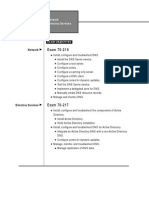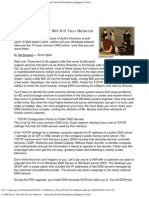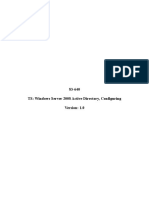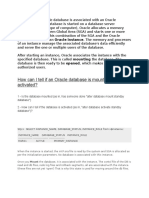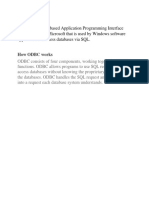Chapter 9 Review Questions
Chapter 9 Review Questions
Uploaded by
jking174Copyright:
Available Formats
Chapter 9 Review Questions
Chapter 9 Review Questions
Uploaded by
jking174Original Title
Copyright
Available Formats
Share this document
Did you find this document useful?
Is this content inappropriate?
Copyright:
Available Formats
Chapter 9 Review Questions
Chapter 9 Review Questions
Uploaded by
jking174Copyright:
Available Formats
Review Questions Chap 9
1. Which of the following best describes DNS? (Choose all that apply.)
a. Hierarchical database
b. Flat database
c. Monolithic database
d. Distributed database
2. Which of the following accurately represents an FQDN?
a. host.top-level-domain.subdomain.domain
b. domain.host.top-level-domain
c. host.subdomain.domain.top-level-domain
d. host.domain.top-level-domain.subdomain
3. A DNS server that cant resolve a query from its local data sends a recursive query to a root
server. True or False?
4. A resource record containing an alias for another record is which of the following record
types?
a. A
b. CNAME
c. NS
d. PTR
5. What type of resource record is necessary to get a positive response from the command
nslookup 192.168.100.10?
a. A
b. CNAME
c. NS
d. PTR
6. When a DNS server responds to a query with a list of name servers, what is the response
called? Referral
7. Youre scanning the local cache on a DNS client, and you run across the notation ::1. What
does this notation mean?
Its the IPv6 localhost address.
8. Your company just opened a small branch office where 10 computer users will work. You
have installed a single Windows Server 2008 computer configured as a member server for
basic file and print server needs. Users require DNS for Internet access and access to company
resources. You decide to install DNS on the existing server. Which of the following
types of installations makes the most sense?
a. A primary server hosting a standard zone
b. An Active Directoryintegrated zone hosting the zone in which the server is a member
c. A caching-only DNS server
d. A server thats a forwarder
9. You have a DNS server outside your corporate firewall thats a stand-alone Windows Server
2008 server. It hosts a primary zone for your public Internet domain name, which is different from your
internal Active Directory domain names. You want one or more of your internal servers to be able to
handle DNS queries for your public domain and to serve as a backup
for the primary DNS server outside the firewall. Which configuration should you choose for
internal DNS servers?
a. Configure a standard secondary zone.
b. Configure a standard stub zone.
c. Configure a forwarder to point to the primary DNS server.
d. Configure an Active Directoryintegrated stub zone.
10. DNS ServerA forwards a query to ForwarderB, which replies with a not found message.
DNS ServerA continues the lookup by querying a root server. True or False?
11. Which of the following is true about a stub zone? (Choose all that apply.)
a. They are authoritative for the zone.
b. Their records are updated by the primary server automatically.
c. They cant be Active Directory integrated.
d. They contain SOA and NS records.
12. You have Windows Server 2008 DNS servers, Windows Server 2003 DNS servers, and
Windows 2000 DNS servers. You just created a new zone, newzone.com, that you want
replicated by Active Directory to all DNS servers. Where should you store the zone?
a. ForestDNSZones partition
b. Newzone.com.dns
c. DomainDNSZones partition
d. Domain partition
13. The DNS server at your headquarters holds a standard primary zone for the abc.com
domain. A branch office connected by a slow WAN link holds a secondary zone for abc.com.
Updates to the zone arent frequent. How can you decrease the amount of WAN traffic
caused by the secondary zone checking for zone updates?
a. In the SOA tab of the zones Properties dialog box, increase the minimum (default) TTL.
b. In the Advanced tab of the DNS servers Properties dialog box, increase the expire
interval.
c. In the SOA tab of the zones Properties dialog box, increase the refresh interval.
d. In the Zone Transfers tab of the SOA Properties dialog box, decrease the retry interval.
14. You have delegated a subdomain to a zone on another server. Several months later, you
hear that DNS clients cant resolve host records in the subdomain. You discover that the
IP address scheme was changed recently in the building where the server hosting the subdomain is
located. What can you do to make sure DNS clients can resolve hostnames in
the subdomain?
a. Configure a forwarder pointing to the server hosting the subdomain.
b. Edit the NS record in the delegated zone on the parent DNS server.
c. Edit the NS record in the delegated zone on the DNS server hosting the subdomain.
d. Configure a root hint pointing to the server hosting the subdomain.
15. You want a DNS server to handle queries for a domain with a standard primary zone hosted
on another DNS server. You dont want your server to be authoritative for that zone. How
should you configure your server? (Choose all that apply.)
a. Configure a secondary zone on your DNS server.
b. Configure a stub zone on your DNS server.
c. Configure a forwarder on your DNS server.
d. Configure a delegation on your Web server.
16. Youre in charge of a standard primary zone for a large network with frequent changes to
the DNS database. You want changes to the zone to be transmitted as quickly as possible to
all secondary servers. What should you configure and on what servers?
Configure DNS notifications on the primary zone
17. You have several hundred client computers using WINS to resolve names of some enterprise
servers. Many of the client computers are laptops used to connect to the network remotely.
Youre trying to eliminate WINS from your network to reduce the number of protocols and
services you must support. What can you do, with the least administrative effort, that allows
you to stop using WINS yet still allows clients computers to use a single-label name for
accessing enterprise servers?
a. Create a GlobalNames zone and add CNAME records for enterprise servers.
b. Create a Hosts file containing servers names and addresses and upload the Hosts file to
each client that needs it.
c. Configure each client computer with the correct domain suffix.
d. Create a stub zone and add CNAME records for each enterprise server.
18. You manage the DNS structure on your network. The network security group has decided
that only one DNS server should contact the Internet. Under no circumstances should
other servers contact the Internet for DNS queries, even if the designated server is down.
You have decided that the DNS server named DNS-Int should be the server allowed to
contact the Internet. How should you configure your DNS structure to accommodate
these requirements?
a. On each DNS server except DNS-Int, configure a forwarder pointing to DNS-Int.
Configure DNS-Int as a forwarder by enabling forwarded requests in the Forwarders tab
of the servers Properties dialog box.
b. On each DNS server except DNS-Int, configure a root hint to point to DNS-Int and
delete all other root hints. Configure a root zone on DNS-Int.
c. On each DNS server except DNS-Int, configure a forwarder pointing to DNS-Int.
Disable the use of root hints if no forwarders are available. No changes are necessary on
DNS-Int.
d. On each DNS server except DNS-Int, in the Advanced tab of the servers Properties
dialog box, disable recursion. No changes are necessary for DNS-Int.
19. You have a zone containing two A records for the same hostname, but each A record has a
different IP address configured. The host records point to two servers hosting a high-traffic
Web site, and you want the servers to share the load. After some testing, you find that youre
always accessing the same Web server, so load sharing isnt occurring. What can you do to
solve the problem?
a. Enable the load sharing option on the zone.
b. Enable the round robin option on both A records.
c. Enable the load sharing option on both A records.
d. Enable the round robin option on the server.
20. Which is the correct order in which a DNS client tries to resolve a name?
a. Cache, DNS server, Hosts file
b. Hosts file, cache, DNS server
c. Cache, Hosts file, DNS server
d. DNS server, cache, Hosts file
21. You want to verify whether a PTR record exists for the AHost.ADomain.com host, but you
dont know the IP address. Which of the following commands should you use?
a. Ping -a AHost.ADomain.com, and then Ping IPAddressreturned from the first Ping
b. Nslookup AHost.ADomain.com, and then Nslookup IPAddressreturned from the first
Nslookup
c. Dnscmd /PTR AHost.ADomain.com
d. Dnslint /PTR AHost.ADomain.com
22. You have been communicating with ComputerB from your workstation for the past several hours. A
colleague informs you that he has just made some changes to the IP addressing scheme on the network
where ComputerB is located. You find that you can no longer
communicate with ComputerB. What tool can you use on your workstation to solve the
problem?
a. Ping
b. Nslookup
c. Ipconfig
d. Dnslint
23. To resolve a query, a DNS server looks in its local cache first. True or False?
24. You have just finished setting up your DNS infrastructure, and the DNS process seems to be
working well. You want to be able to create a baseline of performance data so that if slowdowns occur
later, you have information for comparison purposes. Which tool should you use?
a. Dnscmd.exe
b. Debug logging
c. Performance Monitor
d. Event logging
25. Youre trying to track down a DNS name resolution problem. So far, you havent been able
to get the data you need to see exactly whats happening when DNS queries fail. You need to
see the actual data packets being sent to and from DNS servers. Which tool should you use?
a. Dnslint
b. Debug logging
c. Performance Monitor
d. Nslookup
Question 1
Correct
Mark 1.00 out of 1.00
Flag question
Question text
An A record used to resolve the name in an NS record to
its IP address
glue A record
A query in which the DNS server processes the query
until it responds with an address that satisfies the query
or with an "I don't know" message
recursive query
A list of name servers preconfigured on Windows DNS
servers that point to Internet root servers
root hints
A DNS client that sends a recursive query to a DNS
server
resolver
A type of DNS query to which a DNS server responds
with the best information it has to satisfy the query
iterative query
root hints
forwarder
iterative query
resolver
conditional forwarder
authoritative server
root servers
glue A record
recursive query
Question 2
Correct
Mark 1.00 out of 1.00
Flag question
Question text
If multiple servers are specified in the forwarders tab of a server's Properties, what happens if a query is
made and none of the forwarders provide a response?
Select one:
a. A normal recursive lookup process is initiated, starting with a root server
b. The query is then passed to conditional forwarders
c. The query is cached until it can be resolved
d. The query fails and the DNS server sends a failure reply to the client
Feedback
The correct answer is: A normal recursive lookup process is initiated, starting with a root server
Question 3
Correct
Mark 1.00 out of 1.00
Flag question
Question text
Increased network usage has inspired your staff to install a new DNS server. After much consideration,
you have decided to also make the new server a domain controller as well. One of your interns is curious
as to what benefit this would provide to DNS over simply making the DNS server a member server.
Select one:
a. Resource consolidation
b. The server can do zone transfers for stub zones
c. The AD-integrated domain DNS zones will be created automatically.
d. Active Directory integrated secondary zones would be possible
Feedback
The correct answer is: The AD-integrated domain DNS zones will be created automatically.
Question 4
Correct
Mark 1.00 out of 1.00
Flag question
Question text
Root hints data comes from what file?
Select one:
a. root.hints
b. dns.root
c. Cache.dns
d. root.cache
Feedback
The correct answer is: Cache.dns
Question 5
Correct
Mark 1.00 out of 1.00
Flag question
Question text
What information does a resource record of type MX contain?
Select one:
a. Address of an e-mail server
b. Name server
c. host
d. State of Authority
Feedback
The correct answer is: Address of an e-mail server
Question 6
Correct
Mark 1.00 out of 1.00
Flag question
Question text
What ipconfig option will display the contents of the hosts file, as well as the local DNS cache?
Select one:
a. /showhosts
b. /all
c. /flushdns
d. /displaydns
Feedback
The correct answer is: /displaydns
Question 7
Correct
Mark 1.00 out of 1.00
Flag question
Question text
What is the default no-refresh interval set to on DNS record timestamps?
Select one:
a. 7 hours
b. 7 weeks
c. 7 days
d. 7 years
Feedback
The correct answer is: 7 days
Question 8
Correct
Mark 1.00 out of 1.00
Flag question
Question text
What type of information does a resource record of type A contain?
Select one:
a. Name Server
b. Host
c. State of Authority
d. IPv6 host
Feedback
The correct answer is: Host
Question 9
Correct
Mark 1.00 out of 1.00
Flag question
Question text
Which of the following is not a valid option when configuring packet contents to be logged in the Debug
Logging tab?
Select one:
a. Updates
b. Queries/Transfers
c. Outgoing
d. Notifications
Feedback
The correct answer is: Outgoing
Question 10
Incorrect
Mark 0.00 out of 1.00
Flag question
Question text
Which one of the following options, when added to dnscmd.exe, will allow you to create a new zone?
Select one:
a. /ZoneAdd
b. /Zone Add
c. /Zone -a
d. /ZoneCreate
Feedback
The correct answer is: /ZoneAdd
Question 11
Correct
Mark 1.00 out of 1.00
Flag question
Question text
You have recently set up a new domain controller and DNS server responsible for a large network.
Almost immediately, you notice that every time a user attempts to make use of a resource on a server in
your partner organization's domain, Example.net, DNS requests end up performing a recursive query.
Rather than continue to allow DNS requests to be processed this way, you would like to make use of a
DNS server in Example.net's domain that you have access to via a LAN connection.
What can you configure to have the DNS server in Example.net's domain receive DNS queries from your
network, but only ones that are related to Example.net's domain?
Select one:
a. A forwarder
b. Caching-only DNS server
c. Can't be done
d. Conditional Forwarder
Feedback
The correct answer is: Conditional Forwarder
Question 12
Correct
Mark 1.00 out of 1.00
Flag question
Question text
By default, stale resource scavenging is enabled.
Select one:
True
False
Feedback
The correct answer is 'False'.
Question 13
Correct
Mark 1.00 out of 1.00
Flag question
Question text
Glue A records will also appear as an A record in the zone database.
Select one:
True
False
Feedback
The correct answer is 'False'.
Question 14
Correct
Mark 1.00 out of 1.00
Flag question
Question text
If all zones are hosted on Windows domain controllers and are Active Directory integrated, there's no
need to configure zone transfers because Active Directory replication handles this process.
Select one:
True
False
Feedback
The correct answer is 'True'.
Question 15
Correct
Mark 1.00 out of 1.00
Flag question
Question text
Using a stub zone can result in faster recursive queries.
Select one:
True
False
Feedback
The correct answer is 'True'.
Question 16
Correct
Mark 1.00 out of 1.00
Flag question
Question text
When DNS is installed on a new domain controller, AD-integrated zones are replicated to the new DNS
server automatically.
Select one:
True
False
Feedback
The correct answer is 'True'.
You might also like
- Active Directory Chap 9 ReviewDocument2 pagesActive Directory Chap 9 ReviewXavier Julion63% (8)
- Test Bank Ch3 & Ch4Document9 pagesTest Bank Ch3 & Ch4Darrell NicholasNo ratings yet
- Domain Name SystemDocument16 pagesDomain Name SystemAbdul Khaliq100% (2)
- 70-411 R2 Test Bank Lesson 08Document10 pages70-411 R2 Test Bank Lesson 08Mazaher MohamedaliNo ratings yet
- Interview Ques 411Document15 pagesInterview Ques 411RajEsh SinghNo ratings yet
- Actividad 3Document3 pagesActividad 3Ivone MartinezNo ratings yet
- Welcome: - Basics of DnsDocument21 pagesWelcome: - Basics of DnscsdhimanNo ratings yet
- Lê Song Vũ - DNS and DHCPDocument15 pagesLê Song Vũ - DNS and DHCPPhạm Văn ChiếnNo ratings yet
- 70-411 R2 Test Bank Lesson 09Document11 pages70-411 R2 Test Bank Lesson 09Mazaher Mohamedali100% (1)
- 69.DNS Interview Questions & Answers - Vishnuprasad.cDocument9 pages69.DNS Interview Questions & Answers - Vishnuprasad.cMogan RajNo ratings yet
- Important Roles That DNS Servers Take On:-: Caching-OnlyDocument3 pagesImportant Roles That DNS Servers Take On:-: Caching-OnlysushantNo ratings yet
- Mary Help College: Implementing, Managing, and Maintaining Name ResolutionDocument36 pagesMary Help College: Implementing, Managing, and Maintaining Name Resolutionabenezer abitiNo ratings yet
- DNS TroubleshootingDocument7 pagesDNS TroubleshootingIrfan TarlekarNo ratings yet
- WindowsDocument18 pagesWindowsMohamed thahaNo ratings yet
- Final Exam Comp 213Document11 pagesFinal Exam Comp 213Amanjot SidhuNo ratings yet
- 10.2.2.8 Packet Tracer - DHCP and DNS ServersDocument4 pages10.2.2.8 Packet Tracer - DHCP and DNS ServersKe Syukuran Ku100% (1)
- 070 216Document368 pages070 216ViorelBujorNo ratings yet
- Exam 70-216: Network Directory ServicesDocument92 pagesExam 70-216: Network Directory Servicesanon_667528756No ratings yet
- DNS Interview Questions and AnswersDocument5 pagesDNS Interview Questions and Answersa_d_s_k_india4831No ratings yet
- 2008 DNS InstallationDocument24 pages2008 DNS InstallationPaulNo ratings yet
- DNS (Domain Name System) OverviewDocument8 pagesDNS (Domain Name System) Overviewalimo benNo ratings yet
- CH 10 Dir ReviewJosh MelverDocument5 pagesCH 10 Dir ReviewJosh MelverJosh MelverNo ratings yet
- CSS - Info Sheet 3.2-5 - Respond To Unplanned Events or Conditions - DNSDocument9 pagesCSS - Info Sheet 3.2-5 - Respond To Unplanned Events or Conditions - DNSomarNo ratings yet
- QuestionsDocument10 pagesQuestionsHari ShankerNo ratings yet
- DNS Interview Questions and AnswersDocument4 pagesDNS Interview Questions and AnswersDevang Mehrotra100% (3)
- CIS 2154 - Ch. 2 WorksheetDocument8 pagesCIS 2154 - Ch. 2 WorksheetStrider PutnamNo ratings yet
- Modul DDocument32 pagesModul DRadix -No ratings yet
- DNS Questions: In-Addr - ArpaDocument21 pagesDNS Questions: In-Addr - ArpaWaseem RajaNo ratings yet
- 290 ExamsDocument27 pages290 Examsaref1234No ratings yet
- 10 ReviewDocument5 pages10 Reviewyourelyingtome0% (1)
- DNS FAQsDocument21 pagesDNS FAQsWaseem RajaNo ratings yet
- CIS 2153 - Chapter 3 Worksheet Name - Implementing Name Resolution Using DNS DateDocument5 pagesCIS 2153 - Chapter 3 Worksheet Name - Implementing Name Resolution Using DNS DateMunir WalyaniNo ratings yet
- Q1Document8 pagesQ1anon_593694No ratings yet
- 10.2.2.8 Packet Tracer - DNS and DHCP Instructions IGDocument10 pages10.2.2.8 Packet Tracer - DNS and DHCP Instructions IGFernanda MartínezNo ratings yet
- Dns Server: Phd. Alcides Montoya Canola, Est. Carlos Andres Ballesteros Universidad Nacional de Colombia - Sede MedellinDocument4 pagesDns Server: Phd. Alcides Montoya Canola, Est. Carlos Andres Ballesteros Universidad Nacional de Colombia - Sede MedellinDanielColoradoGaviriaNo ratings yet
- 10 DNS Errors That Will Kill Your NetworkDocument12 pages10 DNS Errors That Will Kill Your NetworkrssebagalaNo ratings yet
- DNS Tech - FaqDocument97 pagesDNS Tech - FaqSamee ChouguleNo ratings yet
- Prepking 70-297 Exam QuestionsDocument11 pagesPrepking 70-297 Exam Questionsarron657No ratings yet
- Linux Unit 4Document6 pagesLinux Unit 4mefalim212No ratings yet
- Linux Dns Server ExposeDocument14 pagesLinux Dns Server ExposeINFO TECNo ratings yet
- Delegate Subdomains in AD DNS For GSLBDocument5 pagesDelegate Subdomains in AD DNS For GSLBsyaamliveNo ratings yet
- TVL - CSS12 - Q2 - M9Document10 pagesTVL - CSS12 - Q2 - M9nino sulitNo ratings yet
- UnboundDocument11 pagesUnboundelipereiramsNo ratings yet
- Las06 DNS 2023.v2Document15 pagesLas06 DNS 2023.v2Damien SeowNo ratings yet
- Bont Test 3Document5 pagesBont Test 3gumbadeaniket1234No ratings yet
- DNS InfoDocument79 pagesDNS InfoKevin_RayNo ratings yet
- PRJ 3Document14 pagesPRJ 3socializam News networkNo ratings yet
- NETW Assignment 6Document5 pagesNETW Assignment 6tudocrisNo ratings yet
- Network Appliance How To Guide: DNS DelegationDocument8 pagesNetwork Appliance How To Guide: DNS DelegationsydabrNo ratings yet
- 83-640 TS: Windows Server 2008 Active Directory, ConfiguringDocument21 pages83-640 TS: Windows Server 2008 Active Directory, ConfiguringKamran MusaNo ratings yet
- Changes To DNSDocument31 pagesChanges To DNSmjrbaconNo ratings yet
- Implement Windows Server DNSDocument13 pagesImplement Windows Server DNSJorge Condor AguilarNo ratings yet
- Technical QuestionsDocument21 pagesTechnical Questionsboopathi84No ratings yet
- Win 2003 AdsDocument24 pagesWin 2003 Adspechimuthu1983No ratings yet
- Exam AZ-800: Administering Windows Server Hybrid Core Infrastructure PreparationFrom EverandExam AZ-800: Administering Windows Server Hybrid Core Infrastructure PreparationNo ratings yet
- MCSA Windows Server 2012 R2 Complete Study Guide: Exams 70-410, 70-411, 70-412, and 70-417From EverandMCSA Windows Server 2012 R2 Complete Study Guide: Exams 70-410, 70-411, 70-412, and 70-417No ratings yet
- How To Build A Website Using Wordpress: Create the website you've always wanted - TodayFrom EverandHow To Build A Website Using Wordpress: Create the website you've always wanted - TodayNo ratings yet
- Network+ Guide To Networks 6th Edition: Transmission Basics and Networking MediaDocument74 pagesNetwork+ Guide To Networks 6th Edition: Transmission Basics and Networking Mediajking174No ratings yet
- Network+ Guide To Networks 6 Edition: An Introduction To NetworkingDocument46 pagesNetwork+ Guide To Networks 6 Edition: An Introduction To Networkingjking174No ratings yet
- Network+ Guide To Networks 6th Edition: Networking Standards and The OSI ModelDocument54 pagesNetwork+ Guide To Networks 6th Edition: Networking Standards and The OSI Modeljking174No ratings yet
- Network+ Guide To Networks 6 EditionDocument72 pagesNetwork+ Guide To Networks 6 Editionjking174No ratings yet
- Network+ Guide To Networks 6th Edition: Topologies and Ethernet StandardsDocument66 pagesNetwork+ Guide To Networks 6th Edition: Topologies and Ethernet Standardsjking174No ratings yet
- Network+ Guide To Networks 6 Edition: Introduction To TCP/IP ProtocolsDocument68 pagesNetwork+ Guide To Networks 6 Edition: Introduction To TCP/IP Protocolsjking174No ratings yet
- Chapter 6 Review QuestionsDocument6 pagesChapter 6 Review Questionsjking174No ratings yet
- Chapter 8 Review QuestionsDocument10 pagesChapter 8 Review Questionsjking174No ratings yet
- Network+ Guide To Networks 5 EditionDocument90 pagesNetwork+ Guide To Networks 5 Editionjking174No ratings yet
- Chapter 9 Review QuestionsDocument12 pagesChapter 9 Review Questionsjking174100% (1)
- Chapter 2 Review QuestionsDocument6 pagesChapter 2 Review Questionsjking174No ratings yet
- Chapter 4 Review QuestionsDocument5 pagesChapter 4 Review Questionsjking174No ratings yet
- Chapter 1 Review QuestionsDocument3 pagesChapter 1 Review Questionsjking174No ratings yet
- Chapter 3 Review QuestionsDocument4 pagesChapter 3 Review Questionsjking174No ratings yet
- Chapter 4 Review Questions - OdtDocument5 pagesChapter 4 Review Questions - Odtjking174No ratings yet
- Chapter 3 Review QuestionsDocument4 pagesChapter 3 Review Questionsjking174No ratings yet
- Chapter 2 Review QuestionsDocument6 pagesChapter 2 Review Questionsjking174No ratings yet
- NOVA Technical Note 6 - Automatic Data RecoveryDocument14 pagesNOVA Technical Note 6 - Automatic Data RecoverysorinamotocNo ratings yet
- Lab 8 Complex SQL Queries: CodeDocument14 pagesLab 8 Complex SQL Queries: CodeNiha RamzanNo ratings yet
- Dynamo DB Basic ConceptsDocument1,090 pagesDynamo DB Basic ConceptsAdesh MatkarNo ratings yet
- Transparent Data EncryptionDocument8 pagesTransparent Data EncryptionnayihbaNo ratings yet
- Qlik Connector For SAPDocument90 pagesQlik Connector For SAPJacekNo ratings yet
- How To Capture A Process Monitor TraceDocument1 pageHow To Capture A Process Monitor TraceNavneetMishraNo ratings yet
- Capstone Story TemplateDocument20 pagesCapstone Story TemplateDustin WeissNo ratings yet
- Off 142q VceDocument16 pagesOff 142q Vcekarunakar.mesNo ratings yet
- ArraysDocument15 pagesArraysd ponnapalliNo ratings yet
- Pic LogDocument3 pagesPic LogAria Hikmadi MaulanaNo ratings yet
- How Can I Tell If An Oracle Database Is Mounted and Activated?Document11 pagesHow Can I Tell If An Oracle Database Is Mounted and Activated?PILLINAGARAJUNo ratings yet
- Welcome To Data Warehouse PresentationDocument38 pagesWelcome To Data Warehouse PresentationRaghuveer ShamannaNo ratings yet
- DM4ML QuizDocument7 pagesDM4ML QuizKishan Kumar JhaNo ratings yet
- Comprehensive New Https PHPDocument19 pagesComprehensive New Https PHPAngel BraceroNo ratings yet
- The Database Development ProcessDocument37 pagesThe Database Development ProcessLidya IndrianiNo ratings yet
- 7.1 Backup Script Project - BriefDocument2 pages7.1 Backup Script Project - Briefa49663487No ratings yet
- JDBC & OdbcDocument18 pagesJDBC & OdbcAyush PrinceNo ratings yet
- Pandas GuideDocument3,071 pagesPandas GuideStocknEarnNo ratings yet
- I3 System User ManualDocument2 pagesI3 System User ManualElemac1No ratings yet
- Tibco Unix CommandsDocument4 pagesTibco Unix CommandsNagagangadhara PadalaNo ratings yet
- Working With PHP and Oracle ADH 401T TUTORIALSDocument16 pagesWorking With PHP and Oracle ADH 401T TUTORIALSDLamolaNo ratings yet
- Useful SAP System TransactionsDocument9 pagesUseful SAP System TransactionsRafael FeherNo ratings yet
- Taylor Swift - Reputation (Digital Booklet)Document6 pagesTaylor Swift - Reputation (Digital Booklet)lulisayisNo ratings yet
- Pentaho Training: Study Guide For Certification ExamsDocument9 pagesPentaho Training: Study Guide For Certification ExamsdevendraNo ratings yet
- Database Programming With SQL Section 17 QuizDocument3 pagesDatabase Programming With SQL Section 17 QuizJosé Obeniel LópezNo ratings yet
- Appendix B Data DictionaryDocument3 pagesAppendix B Data DictionaryMab ShiNo ratings yet
- SQL QueriesDocument27 pagesSQL QueriesBalaNo ratings yet
- Yash ResumeDocument1 pageYash ResumeDeepak KhatriNo ratings yet
- Veeam Backup m365 Customer ScenarioDocument2 pagesVeeam Backup m365 Customer ScenarioDen ClarkNo ratings yet
- MapinfoDocument32 pagesMapinfoMohsin AliNo ratings yet

















